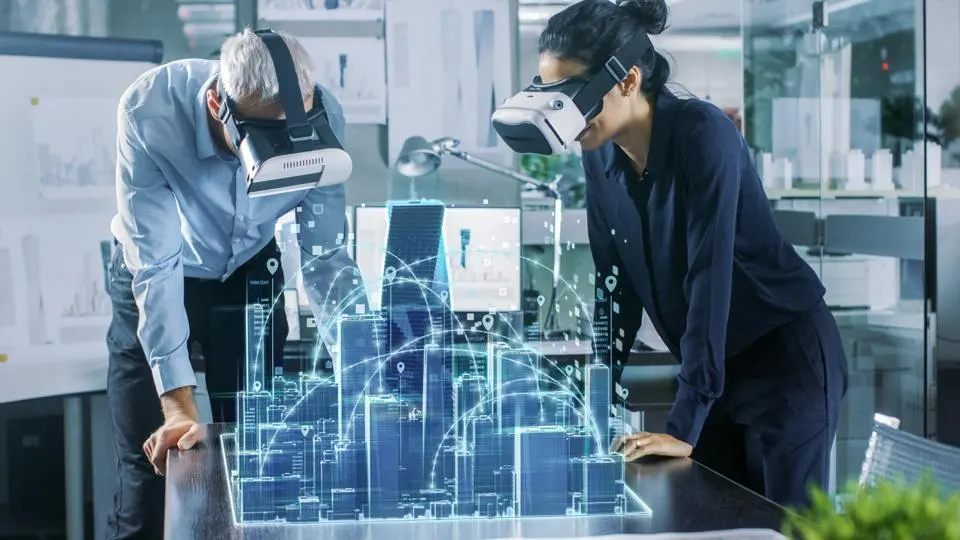Virtual reality brings people that may be separated by thousands of miles together in a digital simulated environment to communicate and collaborate effectively. VR meetings also help companies save on expenses associated with travel by eliminating the need for meeting attendees to come into the office for meetings.
Augmented reality (AR) adds virtual layers to our real world, providing an enhanced business event experience akin to Pokemon Go for corporate meetings and conferences.
3D Meeting Spaces
VR meetings provide an immersive and engaging experience that can increase engagement, collaboration, and productivity in the workplace. They can also foster more flexible work environments by connecting employees across geographies.
Contrasting traditional video conferences, 3D virtual meeting spaces enable participants to interact in more realistic digital environments that feel very real. Participants can work on brainstorming together at a virtual whiteboard, engaging in coffee table conversation or working through complex projects in these virtual meeting spaces.
Advanced tools for interactive whiteboarding, object manipulation and 3D content sharing can also help facilitate more nuanced conversations. Participants can even use features like gesture and body language tracking to enhance conversations even further. In addition, participants can create customized avatars which represent them visually within the metaverse to foster a sense of presence and identity within it; and share data and information through 3D models which all attendees can scrutinize at any time regardless of physical location or time zone for easier decision-making and knowledge retention.
Immersive Collaboration
Even though digital tools for collaboration exist, distributed teams often struggle to come together around goals and establish an environment of shared presence. To counteract this problem, immersive solutions allow remote employees to engage both physical and digital worlds in ways that promote engagement and creativity.
VR solutions provide a realistic environment for virtual meetings, while AR technologies enable interactive presentations and 3D models. AR capabilities may also be applied remotely when building prototypes and products or previsualizing projects.
Immersive technologies combined with appropriate conferencing software can make virtual meetings feel more real, encouraging participation from participants who might otherwise be disengaged due to physical distance or their environment. Virtual reality allows participants to use tools like virtual whiteboards or post-it notes during virtual meetings while augmented reality provides real-time annotations and holographic displays that increase engagement.
Virtual Avatars
Virtual meeting avatars enable participants to connect in ways that exceed the limitations of traditional video conferencing systems, providing attendees with an authentic interaction experience that builds closer bonds among team members and encourages feelings of closeness and belongingness among them.
Businesses using avatars as an effective communication channel with employees located across different timezones or countries will see great benefits from using this approach. Avatars save both money and time while simultaneously decreasing carbon footprints.
Avatars can also be used to host virtual events, like concerts or workshops. VR has already revolutionised music with bands like Gorillaz performing virtual in-game concerts on Fortnite and Snapchat featuring celebrity avatars for fans to experience live performances at home. As technology develops further, avatars will become an indispensable tool in all areas of society to increase collaboration and bring people closer together; leading to metaverse e-commerce where individuals interact as themselves while shopping products or services in an authentic virtual environment that feels real and genuine.
Virtual Meeting Spaces
Virtual Meeting Spaces (VMRs) are immersive digital environments designed to facilitate remote collaboration in 3D. They combine advanced video and audio capabilities with interactive tools for whiteboarding, object manipulation, 3D content sharing and more – including customizable avatars that allow participants to communicate more easily while encouraging deeper levels of connection and engagement between participants.
VR meeting spaces differ from traditional 2D virtual meetings by offering more realism and contextual awareness, which makes for faster decision-making and deeper participant engagement by following nonverbal cues to feel connected to one another more quickly.
VMRs not only enable participants to establish an intuitive virtual workplace environment that feels natural and comfortable for remote workers, but they can also save them money on travel expenses and reduce carbon emissions. They can also be used for conducting regular business meetings and other forms of collaboration such as planning sessions or training events, helping businesses maintain productivity even during disruptions or unexpected absences.
